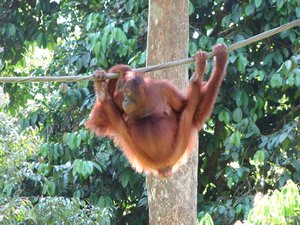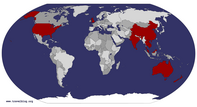Advertisement

 On Display
On Display
Two hung lo Getting the India Visas took slightly longer than anticipated, all in all 7 working days, but after speaking to some New Zealand applicants we were pleased to get them at all and Chris managed at last to pick them up just as we were leaving for the airport - talk about taking it to the wire. A short hop over to Singapore and a short night’s sleep in the Crowne Plaza at the airport (more expensive than we would normally pay but we didn’t have time to go further afield) saw us on the plane the following day for Kota Kinabalu and the land of the “man of the forest”, our closest relatives - the Orang-utans.
The town of Kota Kinabalu, on first inspection, is not a hugely inspiring town but after walking in the blistering sun - yes the sun has returned whoopee - it did have a good selection of places to eat, cafes and bars overlooking the surprisingly clear water and the nearby islands. Oh yes and another major plus, a number of local establishments selling Guinness - could it get any better. Well actually if there are shops that sell Dairy Milk then yes it could!

 No Messing
No Messing
Thats the way to treat trespassers !!!Our accommodation for the first stop in KK was the Borneo Backpackers, we are back to hostels as Malaysia is surprisingly expensive and Borneo even more so. It was okay and as you would expect from a hostel, no frills but functional and not far from everything in town. We headed out for a few hours of exploration just to get our bearings and see what was what. Our first impressions continued - not very inspiring. The following day we headed out to get the bus tickets for our next part of the journey to Sandakan and the main reason for our visit here - Orang-utans. Why oh why Asian countries make it so difficult to get to the popular tourist places, unless of course you want to get ripped off in a taxi or go by organised tour, we don’t know but just getting the bus tickets was an ordeal where we had to walk to one bus station at one end of town to get on a dilapidated bus that hardly made it to the other bus station 15Km outside the town. Then after successfully buying the tickets, after being accosted by loads of touts, we had to

 Fish market
Fish market
and lovely it was toofind the bus back to the first bus station before we could walk back to the hostel - it was a real pain. However, later that evening we managed to find a reason to break a journey at Kota Kinabalu - the night time food market. At night the area by the Handicrafts Market and the rather stinky fish market transforms into a maze of stalls and tables displaying a selection of freshly caught fish which have been semi-cooked and after selecting what you want to eat they are barbequed. We had some squid, tuna and a huge shrimp and with rice for two it came to the staggering total of £6 - not the cheapest we have eaten but it was so delicious. The atmosphere was brilliant as everyone was sitting on bench tables and eating off plastic covered plates - yummy.
The following day we started on our 6hr bus journey which would take us closer to those hairy orange relatives. Passing underneath the shadow of Mount Kinabalu strengthened my resolve to not climb it but increased Chris’ desire to conquer it at some point in the future. At 4101 m high it was huge and a

 Would you
Would you
eat your evening feast here?little intimidating but also incredibly beautiful in its ruggedness. Its jagged peaks make it look menacing and dangerous and its sheer enormity shrouded by cloud dominates the 750 sq km national park. It is easy to see why many are drawn to conquering it each year - still not persuaded though. A nice pleasant walk in the national park was more my thing, as we were determined to do in a few days time.
The route also put into perspective the extent to which Malaysia relies upon the palm oil industry; the devastating impact of the lucrative palm oil on the Malaysian rainforest and the subsequent displacement of our closest relatives, the Orang-utan, were all too clear. Malaysia currently accounts for something like 41% of world palm oil production and 47% of world exports, and the oil palm trees planted here are mainly the tenera variety. 5 million hectares of land in Malaysia is under oil palm cultivation; producing 18 million tonnes of palm oil and 2 tonnes of palm kernel oil. The oil palm tree originated from West Africa and it was introduced to Malaysia by the British in early 1870’s as an ornamental plant. In 1917, the

 Smelly
Smelly
just checkingfirst commercial planting took place in Tennamaran Estate in Selangor, laying the foundations for the vast oil palm plantations and the palm oil industry in Malaysia. However, on the positive side for the Malaysian people, the industry provides employment to more than half a million people and livelihood to an estimated one million people. It is very difficult to justify the devastation in terms of human benefit when you look out over a once rich landscape where once stood primary rainforest which provided a valuable ecosystem to a myriad of creatures and now all that you can see is a swathe of oil palm trees - but then we all rely so much on palm oil! How much, well to list but a few; Cadbury Roses & Dairy Milk, Mars Bars, Clover, Oven Chips, Ginsters pasties, Haribo, Crunchy Nut Cornflakes, Kit Kats, Goodfellas pizza, Pringles, Warburtons bread, Pot Noodle, Wrigleys gum. Non food items like soaps and detergents, candles, cosmetics, and finally, and possibly the biggest future demand, biodiesel. We are all guilty of aiding the disappearance of this important resource. A difficult dilemma.
Sandakan would be our base for a few nights to enable us to do the
quick hop down to Sepilok and the Orang-utan Rehabilitation Centre. Sandakan was the capital of British North Borneo in 1885 and was a thriving commercial centre because of its close proximity to a vast array of natural resources, including timber, beeswax and edible birds’ nests. During WWII the Japanese controlled the area and it was from here that the POW Death March to Ranau began. In 1945 POWs who had survived work in the POW camp, some 1800 Australians and 600 British, were forced by the Japanese to walk 240 km to Ranau through jungle and mud. Of the 2,400 who started only 6 survived. There is a memorial to those soldiers, the locals who helped them and members of the underground movement outside of the town. Eventually the town was almost completely destroyed during WWII by allied intense bombing. Today the town is definitely a stopping over place only to get to the places of interest around and not somewhere you would necessarily choose to stay otherwise. What was once a lovely place which housed many millionaires is now a non-descript concrete sprawl. Our hostel, the May Fair, was cheap, clean and central with an owner of few words
and rather short manner, but with a fabulous DVD selection. After admiring the selection and choosing some to watch we were on good terms.
The journey to the Orang-utan centre was, once again, a real pain, because we had chosen not to go expensively by taxi or on a tour but take the local bus (no 14 we were assured went all the way there). Firstly we were told to get on the bus at the wrong bus stop, then after managing to find someone who could point us in the right direction we got to the right stop but no sign of the 14. Unfortunately as the buses are private everyone wants you to get onto their bus, so trying to establish if we had missed the no. 14 was impossible. So 10 minutes after it was due to leave we thought that we had probably missed it and caught another instead that would drop us off at the junction some 1.5 km from the centre, and from there we would have to walk the rest of the way - not a problem. Well, according to that well known law we passed the no. 14 on its way
back to the bus station - it was just late - typical. After what seemed an age we made it to the junction, which turned out to be 2.5 km away from the centre and because it was blisteringly hot we decided to pay some extra cash and catch one of the taxis which ply their trade on this stretch of road - which was more expensive than the longer bus ride! Eventually we arrived in enough time for the 3pm feeding time. The entrance fee for non-Malyasians is about 6 times more than for the locals - maybe this is something that we should try at home e.g. charging 6 times more for the wives of Malaysian politicians and business people visiting the Tower of London, that would go down well I am sure. I have to admit that for me this was going to be the highlight, as ever since we had started organising the trip this is what I wanted to do. So, incredibly excited we made our way to the feeding platform in enough time to make sure we got front row places: we weren’t going to take any chances not being able to see anything.
Just before 3pm the forest trees and shrubs around the feeding platform started to move tantalisingly as some of the orang-utans made their way towards their afternoon snack; just enough to get a glimpse of a large, orange, hairy arm, but not enough to get a good view. Just then a large orang-utan casually made its way along the ropes, slowly enough so everyone could get lots of photos. It stopped for a bit just to hang there and have a look at us strange, but somehow familiar, creatures before it slowly moved off into the jungle - oh this would be good. Come actual feeding time the keepers climbed the platform and put out two buckets of delicious fruit, followed by one particularly hungry little chap. Over the next 10 minutes 3 little guys sat there stuffing their faces and we were absolutely spell bound by them. They then decided that enough was enough and quietly left the way they came. Now, considering I have been waiting for almost two years to see these chaps I admit to feeling a little let down. I know they are wild animals and therefore unpredictable and I know us humans can’t get

 No you can't
No you can't
touch my nannasany closer to them, but I can’t help it I did think I might see them for more than a few minutes. Never mind our next journey was into the rainforest and if we were really lucky we might see them in their natural habitat.
Advertisement
Tot: 0.128s; Tpl: 0.013s; cc: 9; qc: 52; dbt: 0.0719s; 1; m:domysql w:travelblog (10.17.0.13); sld: 1;
; mem: 1.2mb












Dolly
non-member comment
Palm Trees
I have been looking for Palmtrees websites.Thank You for the info.